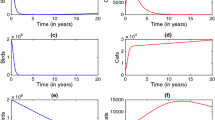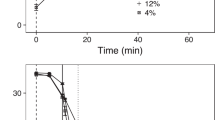Abstract
Due to the responsibility for many illnesses on farmed salmon and inflicting huge financial losses, sea lice treatment has become one of the highest priorities in aquaculture studies. From the viewpoint of dynamics, we consider three stages in sea louse life cycle and study the predator–prey interaction between cleaner fish and sea lice. Through mathematical analysis, we provide two important indexes: the adult reproduction number \({\mathcal {R}}_s\) for sea lice and the net reproductive number of cleaner fish \({\mathcal {R}}_f\), which address the global dynamics relating to \({\mathcal {R}}_s\) and \({\mathcal {R}}_f\) theoretically, including the global/local stability of the equilibria, uniformly persistence and possible Hopf bifurcation. Numerical simulation is provided to show the oscillation behavior in the system.









Similar content being viewed by others
References
Davenport, J.C., Black, K., Burnell, G., Cross, T., Culloty, S., Ekaratne, S., Furness, B., Mulcahy, M., Thetmeyer, H.: Aquaculture: The Ecological Issues. Wiley-Blackwell, New York (2003)
Treasurer, J.W.: A review of potential pathogens of sea lice and the application of cleaner fish in biological control. Pest Manag. Sci. 58, 546–558 (2002)
Lawrence, E.: Henderson’s Dictionary of Biology. Pearson, London (2011)
Allen, E., Victory, H.: Modelling and simulation of a schistosomiasis infection with biological control. Acta Trop. 87, 251–267 (2003)
Gourley, S., Lou, Y.: A mathematical model for the spatial spread and biocontrol of the asian longhorned beetle. SIAM J. Appl. Math. 74, 864–884 (2014)
Lou, Y., Zhao, X.-Q.: Modelling malaria control by introduction of larvivorous fish. Bull. Math. Biol. 74, 2384–2407 (2011)
Deady, S., Varian, S.J.A., Fives, J.M.: The use of cleaner-fish to control sea lice on two irish salmon (Salmo salar) farms with particular reference to wrasse behaviour in salmon cages. Aquaculture 131, 73–90 (1995)
Skiftesvik, A., Bjelland, R., Durif, C.M., Johansen, I.S., Browman, H.I.: Delousing of atlantic salmon (Salmo salar) by cultured vs. wild ballan wrasse (Labrus bergylta). Aquaculture 402, 113–118 (2013)
Liu, Q., Jiang, D., Hayat, T., Alsaedi, A.: Dynamics of a stochastic predator–prey model with stage structure for predator and Holling type II functional response. J. Nonlinear Sci. 28, 1151–1187 (2018)
Al-Darabsah, I., Tang, X., Yuan, Y.: A prey–predator model with migrations and delays. Discrete Contin. Dyn. Syst. Ser. B 21, 737–761 (2016)
Mohr, M., Barbarossa, M.V., Kuttler, C.: Predator–prey interactions, age structures and delay equations. Math. Model. Nat. Phenom. 9, 92–107 (2014)
Song, Y., Xiao, W., Qi, X.: Stability and Hopf bifurcation of a predator–prey model with stage structure and time delay for the prey. Nonlinear Dyn. 83, 1409–1418 (2016)
Dubey, B., Kumar, A.: Dynamics of prey–predator model with stage structure in prey including maturation and gestation delays. Nonlinear Dyn. 96, 2653–2679 (2019)
Groner, M.L., Cox, R., Gettinby, G., Revie, C.W.: Use of agent-based modelling to predict benefits of cleaner fish in controlling sea lice, Lepeophtheirus salmonis, infestations on farmed atlantic salmon, Salmo salar L. J. Fish Dis. 36, 195–208 (2013)
Aldrin, M., Huseby, R.B., Stien, A., Grøntvedt, R.N., Viljugrein, H., Jansen, P.A.: A stage-structured Bayesian hierarchical model for salmon lice populations at individual salmon farms-estimated from multiple farm data sets. Ecol. Model. 359, 333–348 (2017)
Tian, Y., Al-Darabsah, I., Yuan, Y.: Global dynamics in sea lice model with stage structure. Nonlinear Anal. Real World Appl. 44, 283–304 (2018)
Allee, W., Bowen, E.: Studies in animal aggregations: mass protection against colloidal silver among goldfishes. J. Exp. Zool. 61, 185–207 (1932)
Kearn, G.C.: Leeches, Lice and Lampreys: A Natural History of Skin and Gill Parasites of Fishes. Springer, Berlin (2004)
Armstrong, R.: Stable model structures for representing biogeochemical diversity and size spectra in plankton communities. J. Plankton Res. 21, 445–464 (1999)
Oaten, A., Murdoch, W.W.: Functional response and stability in predator–prey systems. Am. Nat. 109, 289–298 (1975)
Cushing, J.M.: An Introduction to Structured Population Dynamics. SIAM, Philadelphia (1998)
Cushing, J.M., Saleem, M.: A predator prey model with age structure. J. Math. Biol. 14, 231–250 (1982)
Allen, L.J.: An Introduction to Mathematical Biology. Pearson, London (2006)
Smorynski, C.: History of Mathematics. Springer, New York (2008)
James, R.: Mathematics Dictionary. Springer, Berlin (1992)
Beretta, E., Kuang, Y.: Geometric stability switch criteria in delay differential systems with delay dependent parameters. SIAM J. Math. Anal. 33, 1144–1165 (2002)
Baker, J., Muller, R., Rollinson, D. (eds.): Advances in Parasitology, vol. 44. Academic Press, London (1999)
Holling, C.S.: The functional response of predator to prey density and its role in mimicry and population regulation. Mem. Entomol. Soc. Can. 97, 5–60 (1965)
Begon, M., Townsend, C.R., Harper, J.L.: Ecology: From Individuals to Ecosystems. Wiley-Blackwell, New York (2005)
Skiftesvik, A.B., Blom, G., Agnalt, A.L., Durif, C.M., Browman, H.I., Bjelland, R.M., Harkestad, L.S., Farestveit, E., Paulsen, O.I., Fauske, M., Havelin, T., Johnsen, K., Mortensen, S.: Wrasse (labridae) as cleaner fish in salmonid aquaculture the hardangerfjord as a case study. Mar. Biol. Res. 10, 289–300 (2014)
Boxshall, G.A., Defays, D.: Pathogens of Wild and Farmed Fish: Sea Lice. CRC Press, Boca Raton (1993)
Sayer, M.D., Treasurer, J.W., Costello, M.J.: Wrasse: Biology and Use in Aquaculture. Wiley-Blackwell, New York (1996)
Hale, J., Lunel, S.V.: Introduction to Functional Differential Equations. Springer, New York (1993)
Smith, H.L.: Monotone Dynamical Systems: An Introduction to the Theory of Competitive and Cooperative Systems. American Mathematical Society, Providence (1995)
Zhao, X.-Q., Jing, Z.: Global asymptotic behavior in some cooperative systems of functional differential equations. Can. Appl. Math. Q. 4, 421–444 (1996)
Zhao, X.-Q.: Dynamical Systems in Population Biology. Springer, New York (2017)
Hirsch, M.W., Smith, H.L., Zhao, X.-Q.: Chain transitivity, attractivity, and strong repellors for semidynamical systems. J. Dyn. Differ. Equ. 13, 107–131 (2001)
Acknowledgements
The authors would like to thank the editor and anonymous referee for their comments that greatly improved our original manuscript.
Funding
This study was funded in part by the NSERC of Canada (203786463102000) and National NSF of China (11571257).
Author information
Authors and Affiliations
Corresponding author
Ethics declarations
Conflict of interest
The authors declare that they have no conflict of interest.
Additional information
Publisher's Note
Springer Nature remains neutral with regard to jurisdictional claims in published maps and institutional affiliations.
Appendices
Appendix A
The proof of Theorem 1.
Proof
The set \(D_X\) is closed in X. Given \(\phi \in D_X\), we define
with
where
Obviously, \(G(\phi )\) is Lipschitz continuous in \(\phi \) in any compact set in \(D_X\). Thus, there is a unique solution in (4) on its maximal existence interval \([0,\sigma _{\phi })\) through \(\phi \) for any \(\phi \in D_X\) [33, Theorem 2.2.3].
Furthermore, it is easy to check that \(G_i(\phi ) \ge 0\) or any \(\phi \in D_X\) with \(\phi _i(m)=0, i=1,2,3\). Hence, by [34, Theorem 5.2.1], \(\phi _i(T)\ge 0\) for all \(t\in [0,\sigma _{\phi }), i=1,2,3\). Therefore, any solution of (4) is nonnegative for any \(t \in [0,\sigma _{\phi })\). In particular, \({\mathcal {C}}(T)>0\) when \({\mathcal {C}}(m)>0\) because
for any when \(\phi \in D_X\). Similarly, the positivity of \({\mathcal {A}}(T)\) and \({\mathcal {W}}(T)\) is followed when \({\mathcal {A}}(m)>0\) and \({\mathcal {W}}(m)>0\).
To show the boundedness of the system, let \({\tilde{\mu }}=\min \left\{ \mu _{C},\mu _{A},\mu _{W}\right\} \). Since \(b(t)\le B(t)\) is a nondecreasing function and both \({\mathcal {C}}\) and \({\mathcal {W}}\) are nonnegative, it follows from (4) that
Therefore, \({\mathcal {C}}+{\mathcal {A}}+{\mathcal {W}}\) is bounded ( [35, Theorem 3.2]). Thus, all solution of (4) are bounded because \({\mathcal {C}}, {\mathcal {A}}\) and \({\mathcal {W}}\) are nonnegative. Hence, by [33, Theorem 2.3.1], we have \(\sigma _{\phi }=+\infty \). Thus, all the solutions are ultimately bounded and exist globally. Thus, there exists \(T_1>0\) and \(K>0\) such that \(0 \le \{{\mathcal {C}}(T),{\mathcal {A}}(T),{\mathcal {W}}(T)\} \le {K}\) for \(T>T_1\). \(\square \)
Appendix B
The proof of Theorem 2.
Proof
When \({\mathcal {R}}_s<1\), we know that (0, 0) is a globally attractive equilibrium point in the system obtained from (26) by replacing \(\le \) with \(=\), see [16, Theorem 4.1]. By the comparison principle (see e.g., [34, Theorem 5.1.1]) and the nonnegativity of \({{{\mathcal {C}}}}(T)\) and \({{{\mathcal {A}}}}(T)\), we obtain
Denote \(\Phi (T)(\phi _{_{\mathcal {CW}}}):= {\hat{z}}_T(\phi _{_{\mathcal {CW}}})\) be the solution semiflow associated with (4). Let \(\omega =\omega (\phi _{_{\mathcal {CW}}})\) be the omega limit set of \(\Phi (T)\). By [36, Lemma 1.2.1], \(\omega \) is an internally chain transitive set for \(\Phi (T)\). Thus, \(\omega =\{(0,0)\}\times {\bar{\omega }}\) for some \({\bar{\omega }}\subset {\mathbb {R}}\). It is easy to see that
where \(\hat{\Phi }(T)\) is the solution semiflow associated with the equation
Since \(\omega \) is an internally chain transitive set for \(\Phi (T)\), it easily follows that \({\bar{\omega }}\) is an internally chain transitive set for \(\hat{\Phi }\).
Obviously, \(\{0\}\) is globally asymptotically stable for (27), and we get \({{{\bar{\omega }}} } \cap W^s\left( 0 \right) \ne \emptyset \), where \(W^s\left( 0 \right) \) is the stable manifold of 0. Thus, \({\bar{\omega }}=\{0\}\) (see e.g., [37, Theorem 3.2 and Remark 4.6] or [36, Theorem 1.2.1]). Therefore, we have \(\omega =\{(0,0,0)\}\), and hence
Together with the local stability of (0, 0, 0) (similar proof as in [16] [Theorem 3.1], we obtain the global asymptotic stability of (0, 0, 0) when \({\mathcal {R}}_s<1\) and the instability as \({\mathcal {R}}_s>1\). \(\square \)
Appendix C
The proof of Theorem 3.
Proof
From [16, Theorem 4.3], when \({\mathcal {R}}_s>1\), \(({\mathcal {C}}_1^*,{\mathcal {A}}_1^*)\) is a globally attractive equilibrium point in the system
By the comparison principle (see e.g., [34, Theorem 5.1.1]), we obtain
Next, we prove \({\mathcal {W}}(T)\rightarrow 0\) as \(T\rightarrow \infty \) when \({\mathcal {R}}_f<1\). Let \({T}_2\) be sufficiently large, from (4c), we get
for \(T\ge {T}_2\). Therefore,
Hence,
due to the nonnegativity of \({\mathcal {W}}\).
Hence, the limiting system of system (4) is same as (28). Thus, the omega limit set of the solution semiflow \(\Phi (T)\) of system (4) is \(\omega =\bar{{\bar{\omega }}} \times 0\) for some \( \bar{{\bar{\omega }}} \subset {\mathbb {R}}\times {\mathbb {R}}\).
Claim 1
\(\bar{{{\bar{\omega }}} }\not \subset \left\{ {\left( {0,0} \right) } \right\} \cup \left\{ {\left( {0,{\bar{y}}} \right) :{\bar{y}} \ne 0} \right\} \cup \left\{ {\left( {{\bar{x}},0} \right) :}\right. \left. {{\bar{x}} \ne 0} \right\} \).
By contrary, first, assume \(\bar{{{\bar{\omega }}} }\subset \left\{ {\left( {0,{\bar{y}}} \right) :{\bar{y}} \ne 0} \right\} \). Then,
When \({\mathcal {R}}_s>1\), the solutions of (28) satisfy \(\liminf \limits _{T\rightarrow \infty } ({\mathcal {C}}(T),{\mathcal {A}}(T))\ge (\eta _1,\eta _1)\) for some positive number \(\eta _1>0\) [16, Theorem 4.2]. Thus,
Let \({T}_3>0\) be sufficiently large. Then, it follows from (28a) that
Therefore, \({\mathcal {C}}(T)\rightarrow \infty \) as \(T\rightarrow \infty \), a contradiction.
Now, assume that \(\bar{{{\bar{\omega }}} }\subset \left\{ {\left( {{\bar{x}},0} \right) :{\bar{x}} \ne 0} \right\} \). Then,
Let \({T}_4>0\) be sufficiently large. Then, it follows from (28b) that
Therefore, \({\mathcal {A}}(T)\rightarrow \infty \) as \(T\rightarrow \infty \), which contradicts the boundedness of solutions. This proves the claim.
For any \(\phi _{_{\mathcal {CW}}}\in {D_{Y}}\), we have
where \({\tilde{\Phi }}(T)\) is the solution semiflow associated with system (28). By [36, Lemma 1.2.1], \(\omega \) is an internally chain transitive set, and hence, \(\bar{{{\bar{\omega }}} }\) is an internally chain transitive set for \({\tilde{\Phi }}\). Since \(({\mathcal {C}}_1^*,{\mathcal {A}}_1^*)\) is a globally attractive in (28) and from Claim 1, we get \(\bar{{{\bar{\omega }}} } \cap W^s\left( {\mathcal {C}}_1^*,{\mathcal {A}}_1^* \right) \ne \emptyset \), where \(W^s\left( {\mathcal {C}}_1^*,{\mathcal {A}}_1^* \right) \) is the stable manifold of \(\left( {\mathcal {C}}_1^*,{\mathcal {A}}_1^* \right) \). Then, it follows from [36, Theorem 1.2.1] (or [37, Theorem 3.2 and Remark 4.6]) that \(\bar{{{\bar{\omega }}} }=\left( {\mathcal {C}}_1^*,{\mathcal {A}}_1^* \right) \). This proves that \(\omega =\left( {{{\mathcal {C}}}}_1^*, {{{{\mathcal {A}}}}_1^*,0} \right) \). Consequently,
for any \(\phi _{_{\mathcal {CW}}}\in {D_{Y}}\) with \({\mathcal {C}}_m>0, \hat{\phi }(m)>0\), that is, \(\left( {\mathcal {C}}_1^*,{\mathcal {A}}_1^*,0 \right) \) is globally attractive. This completes the proof. \(\square \)
Appendix D
The proof of Theorem 4.
Proof
Let
and
where \(\partial Y_{0}=Y \setminus Y_{0}=Y_{1}\cup Y_{2}\cup Y_{3}\).
For \(i=1,2\), fix a small \(\epsilon _i>0\). Since \(\mathop {\lim }\limits _{{{{\mathcal {A}}}} \rightarrow 0} \frac{{b\left( {{{\mathcal {A}}}} \right) }}{{{{{\mathcal {A}}}}P({\mathcal {A}})}} = \frac{{b'(0)}}{{{P_0}}}\) and \(\mathop {\lim }\limits _{{{{\mathcal {A}}}} \rightarrow 0} {{{\mathcal {A}}}}f({{{\mathcal {A}}}}) = 0\), in a neighborhood of \({\mathcal {A}}=0\), we have
respectively. Set \(\epsilon _3=\max \{\epsilon _1,\epsilon _2\}\).
Claim 2
There exists a \(\delta _1(\epsilon _3)>0\), such that for any \(\phi _{_{\mathcal {CW}}}\in Y_{0}\),
By contradiction, suppose that \(\limsup \limits _{T\rightarrow \infty } \Vert {\hat{z}}_{T}(\psi _{_{\mathcal {CW}}})-E_0\Vert < \delta _1(\epsilon _3)\) for some \(\psi _{_{\mathcal {CW}}}\in Y_0\). Thus, there exists \(T_5 > m\) such that \( \left| {\mathcal {A}}(T)\right| <\delta _1(\epsilon _3)\) for \(T>T_5+m\). Hence, (29) is satisfied.
From (4), we obtain
The characteristic equation of the system obtained from (30) by replacing > with \(=\) is
where
Obviously, it is enough to study the roots in \({\Delta _2}(\lambda )=0\). Let \(\lambda _2(\epsilon _3)\) be the principal eigenvalue. When \(\epsilon _3=0\), the obtained system is irreducible and quasimonotone; hence, it is enough to study only the real roots in (31) (see [34, Theorem 5.5.1]). It is clear that \(\Delta _2(0)<0\) when \({\mathcal {R}}_s>1\). Therefore, due to the continuity of \({\Delta _2}(\lambda )\) and \(\mathop {\lim }\limits _{\lambda \rightarrow \infty } {\Delta _2}(\lambda ) = + \infty \), there exists \({\bar{\lambda }}>0\) such that \({\Delta _2}({\bar{\lambda }} )=0\). Thus, \(\lambda _2(0)>0\), and hence, \(\lambda _2(\epsilon _3)>0\) for sufficiently small \(\epsilon _3>0\) because of the continuity of \(\lambda _2\). Thus, there exists a solution \(\mathbf {V_1}(T)=\mathrm{e}^{\lambda _2(\epsilon _3)T}\hat{\xi }\), where \(\hat{\xi }\) is the positive eigenfunction corresponding to \(\lambda _2(\epsilon _3), \mathbf {V_1}\) and \(\hat{\xi }\) are vectors with three components. Since \({\mathcal {C}}(T), {\mathcal {A}}(T)\) and \({\mathcal {W}}(T)\) are nonnegative for all \(T > m\), the comparison arguments imply that there exists a small \(\ell _1 > 0\) such that \(({\mathcal {C}}(T),{\mathcal {A}}(T),{\mathcal {W}}(T))\ge \ell _1 \mathrm{e}^{\lambda _2(\epsilon _3)T}\hat{\xi }\) for all \(T\ge T_5+m\) [34, Theorem 5.1.1]. Since \(\lambda _2(\epsilon _3)>0\), we have \(\mathop {\lim }\limits _{T \rightarrow \infty } ({\mathcal {C}}(T),{\mathcal {A}}(T),{\mathcal {W}}(T)) = \infty \), which is a contradiction because all solutions in system (4) are bounded. This proves the claim.
Since \(\mathop {\lim }\limits _{{{{\mathcal {A}}}} \rightarrow {\mathcal {A}}_1^*} {{{\mathcal {A}}}}f({{{\mathcal {A}}}}) = {\mathcal {A}}_1^*f({\mathcal {A}}_1^*)\), in a neighborhood of \({\mathcal {A}}={\mathcal {A}}_1^*\), there exists a small \(\epsilon _4>0\) such that
Claim 3
There exists a \(\delta _2(\epsilon _4)=\delta _2>0\), such that for any \(\phi _{_{\mathcal {CW}}}\in Y_{0}\),
By contradiction, suppose that \(\limsup \limits _{T\rightarrow \infty } \Vert {\hat{z}}_{T}({\bar{\psi }}_{_{\mathcal {CW}}})-E_1\Vert < \delta _2(\epsilon _4)\) for some \({\bar{\psi }}_{_{\mathcal {CW}}}\in Y_0\). Hence, there exists \(T_6 > m\) such that \( \left| {\mathcal {A}}(T)-{\mathcal {A}}_1^*\right| <\delta _2(\epsilon _4)\) for \(T>T_6+m\). From (4), we have
The characteristic equation of the system obtained from (32) by replacing > with \(=\) is
When \(\epsilon _4=0\), \(\lambda =\frac{{\mathcal {R}}_f-1}{\mu _WP({\mathcal {A}}^*_1)}\) is a positive root in \({\Delta _3}(\lambda )=0\) if \({\mathcal {R}}_f >1\). Hence, the principal eigenvalue is positive. By similar arguments as those in the proof of Claim 2, we have \(({\mathcal {C}}(T),{\mathcal {A}}(T),{\mathcal {W}}(T))\rightarrow \infty \) as \(T\rightarrow \infty \), resulting a contradiction.
Let \(\hat{\omega }(\phi _{_{\mathcal {CW}}})\) be the omega limit set of the orbit \({\hat{z}}_{T}(\phi _{_{\mathcal {CW}}})\) through \(v\in {D_{Y}}\).
Claim 4
\(\bigcup \left\{ \hat{\omega }(\phi _{_{\mathcal {CW}}}):\phi _{_{\mathcal {CW}}} \in {M_\partial } \right\} = E_0\cup E_1\).
For any \(\phi _{_{\mathcal {CW}}}\in M_\partial \), we have \({\hat{z}}_T(\phi _{_{\mathcal {CW}}})\in Y_1\) or \({\hat{z}}_T(\phi _{_{\mathcal {CW}}})\in Y_2\) or \({\hat{z}}_T(\phi _{_{\mathcal {CW}}})\in Y_3\). If \({\hat{z}}_T(\phi _{_{\mathcal {CW}}})\in Y_1\), i.e., \({\mathcal {C}}(T)\equiv 0\), then from (4b) we have
By the comparison arguments, we have \(\lim _{T\rightarrow \infty }{\mathcal {A}}(T)=0\). It then follows from (4c) that
Hence, \(\lim _{T\rightarrow \infty }{\mathcal {W}}(T)=0\).
Similarly, when \({\hat{z}}_T(\phi _{_{\mathcal {CW}}})\in Y_2\), i.e., \({\mathcal {A}}(T)\equiv 0\), it follows from (4a) and (4c) that
respectively. Thus, \({\mathcal {C}}(T)\rightarrow 0\) and \({\mathcal {W}}(T)\rightarrow 0\) as \(T\rightarrow \infty \).
If \({\hat{z}}_T(\phi _{_{\mathcal {CW}}})\in Y_3\), i.e., \({\mathcal {W}}(T)\equiv 0\), then (4) becomes (28). Since \({\mathcal {R}}_{s} > 1\), (\(\hbox {Q}_1\))–(\(\hbox {Q}_3\)), (\(\hbox {H}_2\)) and (\(\hbox {H}_3\)) hold, it follows from [16, Theorem 4.3] that \( \left( {\mathcal {C}}(T),{\mathcal {A}}(T)\right) \rightarrow \left( {\mathcal {C}}_1^*,{\mathcal {A}}_1^* \right) \) as \(T\rightarrow \infty \). Hence, \(\bigcup \left\{ \hat{\omega }(\phi _{_{\mathcal {CW}}}):\phi _{_{\mathcal {CW}}} \in {M_\partial } \right\} = E_0\cup E_1\). Thus, the claim holds.
Define a continuous function \(\rho _2:D_{Y}\rightarrow {\mathbb {R}}_+\) by
It is clear that \(\rho ^{-1}(0,\infty )\subset Y_0\) and if \(\rho (\phi _{_{\mathcal {CW}}})>0\) then \(\rho ({\hat{z}}_T(\phi _{_{\mathcal {CW}}}))>0\) for all \(T>m\). By Claim 4, we know that any forward orbit of \({\hat{z}}_T\) in \(M_{\partial }\) converges to either \(E_0\) or \(E_1\). We further conclude \(E_0\) and \(E_1\) are two isolated invariant in Y, and \(\left( W^s(E_0)\cup W^s(E_1)\right) \cap Y_0 = \emptyset \) and no subset of \(\{E_0,E_1\}\) form a cycle in \(\partial Y_0\), from Claims 2 and 3. Thus, there exists \(\eta _2>0\) such that \(\liminf \limits _{T\rightarrow \infty } ({\mathcal {C}}(T),{\mathcal {A}}(T),{\mathcal {W}}(T))\ge (\eta _2,\eta _2,\eta _2)\) for any \(({\mathcal {C}}_m,\hat{\phi },{\mathcal {W}}_m)\in Y_0\) implying the uniform persistence. The proof is complete. \(\square \)
Rights and permissions
About this article
Cite this article
Al-Darabsah, I., Yuan, Y. Dynamic analysis of a biocontrol of sea lice by age-structured model. Nonlinear Dyn 97, 1649–1666 (2019). https://doi.org/10.1007/s11071-019-05088-1
Received:
Accepted:
Published:
Issue Date:
DOI: https://doi.org/10.1007/s11071-019-05088-1




